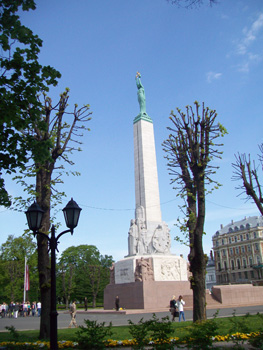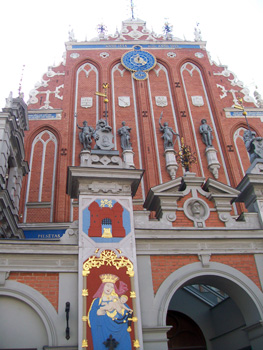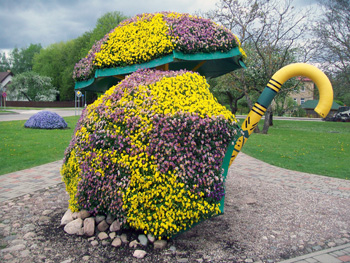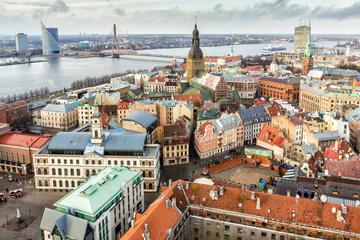
by Marc Latham
Looking at Latvian history from a British point of view it seems as if the formation of their country is about a tenth the age of ours, as Latvia became independent in 1918, while modern Britain started to form after its last invasion in 1066. Both regions had a lot of history before, and both have had a lot of history since.
 Latvia now attracts tourists with a mix of modernity at Riga bars and beaches; history in Riga’s Old Town, museums and countryside towns; and one of the most conserved natural habitats in Europe. I fitted in a little of each, but my main reason to visit the Baltic nation was to take part in the 2016 marathon.
Latvia now attracts tourists with a mix of modernity at Riga bars and beaches; history in Riga’s Old Town, museums and countryside towns; and one of the most conserved natural habitats in Europe. I fitted in a little of each, but my main reason to visit the Baltic nation was to take part in the 2016 marathon.
The Riga marathon is a symbol of the Latvian success story, growing from a few hundred Latvian competitors in 1991 to 1700 runners from sixty-five countries in 2016. There were over 30,000 runners taking part in different races over the running festival weekend.
 I completed a little personal history of my own with my fifth marathon at fifty, after setting a target of running one every three years until this year after running my first in 2004. The marathon dominated my five days in Latvia, but I still managed to see a lot of sights, while preparing for the run, during the event, and the day afterwards.
I completed a little personal history of my own with my fifth marathon at fifty, after setting a target of running one every three years until this year after running my first in 2004. The marathon dominated my five days in Latvia, but I still managed to see a lot of sights, while preparing for the run, during the event, and the day afterwards.
I arrived on the Thursday before the Sunday event, on a low-cost flight along with a stag party or two, with Riga having become a renowned city for such occasions. I found my hotel on the edge of the centre with the help of a couple of bus drivers, and caught up with some sleep after traveling overnight and early morning on train and plane. The en-suite room with television and wifi was luxurious compared to the hostels I usually use. I thought I needed some home comforts for the marathon, and think it was certainly worth it for the extra sleep I probably gained. The breakfast buffet was also good for a nutritious start to the day.
After leaving the hotel on the Friday aiming to pick up my race number and info pack at the expo I ended up seeing the Old Town first, and most of the centre too. It was hard to believe the city had seen so much war and occupation over the last century, walking around its green parks and cobbled streets in glorious spring sunshine.
 I arrived in the centre from the eastern park belt, seeing the 150-foot high Freedom Monument without previously knowing about it. The next day it was the starting point for the marathon’s Parade of Nations, and during the marathon two lines of local volunteers in traditional costumes and enchanting music provided a magical passage at the end of the course. The monument was built in 1935, and wasn’t harmed by the Soviet army during its control of the region from World War Two to the Gorbachev presidency. The monument was a rallying point for independence rallies from 1987 to Latvia’s independence in 1991.
I arrived in the centre from the eastern park belt, seeing the 150-foot high Freedom Monument without previously knowing about it. The next day it was the starting point for the marathon’s Parade of Nations, and during the marathon two lines of local volunteers in traditional costumes and enchanting music provided a magical passage at the end of the course. The monument was built in 1935, and wasn’t harmed by the Soviet army during its control of the region from World War Two to the Gorbachev presidency. The monument was a rallying point for independence rallies from 1987 to Latvia’s independence in 1991.
Continuing west, the cobbled streets of the Old Town are visible from the park under the monument, whose greenery is decorated with fountains, flowers and small statues. While Latvia’s independent history is relatively new, Riga has been in existence since the thirteenth century.
 Walking directly down from the Freedom Monument takes you between the two main historic sites in Riga: Doma Laukums (Cathedral Square) and Town Hall Square. In the former, Riga’s cathedral is the biggest in the Baltics, according to the Rough Guide, ‘…it was begun in 1211 by Albert von Buxhoeveden, the warrior-priest who founded Riga and became its first bishop.’ In the latter, St. Peter’s church combines with Melngavju Nams (House of the Blackheads) and City Hall to create an excellent panoramic circuit. Melngavju Nams was the meeting place for a 14th-century brotherhood of traders that venerated St. Maurice, a warrior of North African descent. The area has been extensively rebuilt since independence, after the original buildings were bombed and demolished during twentieth-century wars.
Walking directly down from the Freedom Monument takes you between the two main historic sites in Riga: Doma Laukums (Cathedral Square) and Town Hall Square. In the former, Riga’s cathedral is the biggest in the Baltics, according to the Rough Guide, ‘…it was begun in 1211 by Albert von Buxhoeveden, the warrior-priest who founded Riga and became its first bishop.’ In the latter, St. Peter’s church combines with Melngavju Nams (House of the Blackheads) and City Hall to create an excellent panoramic circuit. Melngavju Nams was the meeting place for a 14th-century brotherhood of traders that venerated St. Maurice, a warrior of North African descent. The area has been extensively rebuilt since independence, after the original buildings were bombed and demolished during twentieth-century wars.
Farther west towards the Daugava River is Riflemen’s Square, centred on a statue leftover from the Soviet era. The riflemen’s first action was fighting against German forces in World War One, with the Kaiser’s forces having reached the other side of the city’s major river. Where the Latvian riflemen once faced their foe in deadly battle was now the start/finish area for the marathon, and the course took us back and forth across the 1500-foot cable-stayed Vansu Bridge joining west and east Riga. I have fond memories of the bridge; having found a second wind before returning across it, I felt as if I was running with the wind only a few miles from completing the marathon and my ambition.
I unfortunately only had one day left in Latvia after the marathon, meaning I missed the historic town of Cesis, and the coastal resort of Jurmala. That’s because I chose to visit Sigulda, after reading of abundant nature in the Gauja Valley. The train journey just over an hour inland (33 miles) was punctual and pleasant, seeing ample evidence of Latvia’s prestigious woodlands along the way. About forty per-cent of Latvia is still wooded, with half of it pine forests.
 I was impressed by Sigulda’s wide spaces and parks as I walked towards the Gauja River. Paramount was Walking Stick park, a colourful tribute to the region’s top souvenir, with cane-making having a 200 years history in the area. Sigulda is also the adventure capital of Latvia, with summer and winter activities, such as cable car bungee jumping, tobogganing and a ski slope. I had intended taking the cable car across the lush Gauja valley, but instead found myself hobbling down the steep slope to the river. Seeing a little beach on the other side drew me across the bridge, and I sat in the sun on the sand for a little while.
I was impressed by Sigulda’s wide spaces and parks as I walked towards the Gauja River. Paramount was Walking Stick park, a colourful tribute to the region’s top souvenir, with cane-making having a 200 years history in the area. Sigulda is also the adventure capital of Latvia, with summer and winter activities, such as cable car bungee jumping, tobogganing and a ski slope. I had intended taking the cable car across the lush Gauja valley, but instead found myself hobbling down the steep slope to the river. Seeing a little beach on the other side drew me across the bridge, and I sat in the sun on the sand for a little while.
I saw the top of a castle in the distance, and after checking the map realised it was Turaida, which is considered the best of the three Medieval castles either side of the river. A scenic two miles away, mostly through a wooded park trail alongside the Gauja, the views from the castle tower alone were worth the walk and entrance fee. The Gauja river was visible in the distance to the east and west, snaking its way through dense forests for miles around, including just to the south of the castle.
 There was much more to see and read though, starting with an old church, and followed by an excellent little museum tracing the ancestry of the region over its last 1000 years. The Gauja Livs who built Turaida were of Finno-ugrian heritage, in the southern Urals, like many in the north-east of Europe. They were a pagan people who resisted Christian crusaders, but were eventually integrated into western Medieval European culture. A film in one of the rooms showed how the castle looked in its prime, and it was easy to imagine the inhabitants of 800 years ago riding into the forecourt and dismounting after a long ride through pristine forests. The castle was centrally heated below the archbishop of Riga’s room, in the south of the castle, overlooking the valley. The castle was a refuge for the archbishop, as well being economically important.
There was much more to see and read though, starting with an old church, and followed by an excellent little museum tracing the ancestry of the region over its last 1000 years. The Gauja Livs who built Turaida were of Finno-ugrian heritage, in the southern Urals, like many in the north-east of Europe. They were a pagan people who resisted Christian crusaders, but were eventually integrated into western Medieval European culture. A film in one of the rooms showed how the castle looked in its prime, and it was easy to imagine the inhabitants of 800 years ago riding into the forecourt and dismounting after a long ride through pristine forests. The castle was centrally heated below the archbishop of Riga’s room, in the south of the castle, overlooking the valley. The castle was a refuge for the archbishop, as well being economically important.
From the Archbishop’s room and tower, Sigulda Castle was visible across and to the east of the bridge, so I walked back to the town that way, passing under the colourful castle framed beautifully by blue sky. I hadn’t expected that day to include so much history, and walking, and didn’t know, or remember, until now, that the Rough Guide describes Sigulda as ‘…not so much a town as a vast leafy park tastefully scattered with a few houses and apartment blocks.’
I hope Latvia can retain its natural beauty, and that its example will lead western Europe, rather than it being forced or persuaded to deforest, and lose its impressive amounts of wildlife.

Best of Riga: Riga City Tour by Coach and Foot
If You Go:
References
♦ Guide Book: The Rough Guide to Estonia, Latvia & Lithuania
♦ Riga
♦ Turaida museum
♦ Guaja National Park
Getting Around
♦ There are cheap flights from the U.K. I flew with Ryanair
♦ I stayed at the Baltpark hotel
♦ Riga tourist office is on Town Hall Square
About the author:
Marc Latham travelled to all the populated continents during his twenties. He studied during his thirties, including a BA in History, and spent his forties creative writing. He lives in Leeds, writing from the www.greenygrey3.com/website. He has had a Magnificent Seven books published, most recently completing a trilogy of comedy fantasy travel by web maps and information. The blogged book’s theme might have inspired the return of the X Files. The Truth is Out There and all that, and the books are available on Amazon and other bookstores.
All photographs are by Marc Latham:
Town Hall Square
Freedom monument
Latvia marathon
St. Peter’s Church
House of the Blackheads
City Hall
Walking Stick park





Leave a Reply
You must be logged in to post a comment.